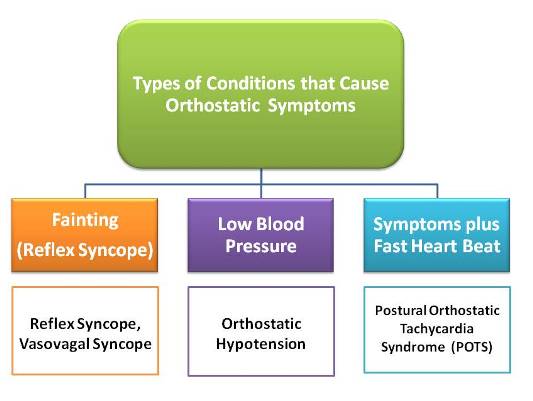Types of Orthostatic Intolerance:
There are 3 types of orthostatic problems that can cause people to get dizzy and have other symptoms when they stand up (or sit up). (There are more symptoms than just dizziness, nausea, weakness and fatigue with OI. For a more complete list, check out Symptoms of OI).
The orthostatic symptoms with standing up are the same for the different types of OI. Difference scenarios or experiences of the person with

- Fainting - With fainting, the person would stand up, get dizzy or /lightheaded plus other symptoms and then pass out! It all happens pretty fast!
- Low Blood Pressure - The person would get symptoms that start after standing up for a few minutes. The symptoms go away when you sit down or lie down. The heart rate doesn't change. [This could be due to a low blood pressure that comes when you stand up - medically called orthostatic hypotension (OH)].
- Fast Heart Beat - The person gets symptoms after standing for anywhere from 1 minute up to 10 minutes; the heart races really fast, faster than 120 beats a minute. Things settles down when you lie down. (This could be Postural Orthostatic Tachycardia Syndrome - POTS.
Can you have more than 1 type of orthostatic problem?
YES, it is possible to have more than one problem causing orthostatic symptoms. After the first problem and symptom, if a person continues to stand up, they could develop a second one. For example, a person could get POTS within the first 10 minutes and then in about 30 minutes, develop a low blood pressure (NMH).
How do you know - or your doctor know - what type of problem you have?
The blood pressure and pulse are used to decide which type of orthostatic condition is present. They can be measured in the office or by a special tests such as the tilt-table test.
Is the treatment or management different for the different types of problems?
The management is different in some cases. Some of the same approaches are used for syncope as for the others but there are some differences especially in medications. There are different causes for orthostatic hypotension. The management depends on what is causing the problem.
The basic management for neurally mediated hypotension (NMH) and POTS is the same with some differences when medications are used.
Symptoms of Orthostatic Intolerance (OI).
Type of Orthostatic Conditions by When the Symptoms Start. - to match when symptoms start with blood pressure or pulse changes
For another perspective on the overlap between OH / NMH and POTS, check out Types of OI under the Causes - Dysautonomia.
References
- Moya Guidelines for the diagnosis and management of syncope (version 2009). European Heart Journal (2009); 30: 2631-2671.
Author: Kay E. Jewell, MD
Page Last Updated: September 9, 2012
